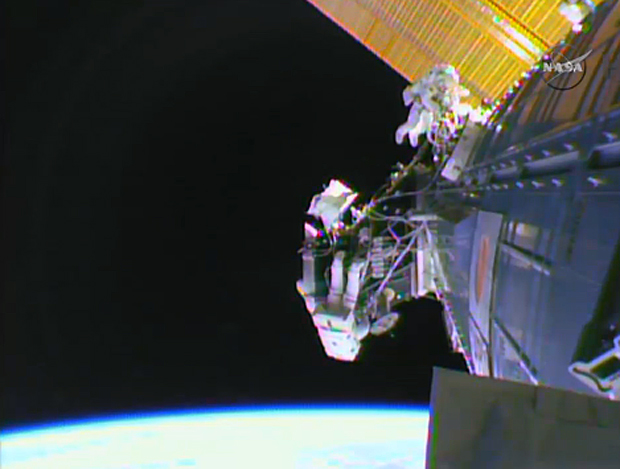Second spacewalk advances space station upgrades
Astronauts Barry "Butch" Wilmore and Terry Virts floated back outside the International Space Station Wednesday for the second of three spacewalks to help ready the lab complex for dockings by commercial crew capsules being built by Boeing and SpaceX.
Floating in the Quest airlock module, Wilmore and Virts switched their spacesuits to battery power at 6:51 a.m. EST (GMT-5) to officially kick off a planned six-and-a-half-hour spacewalk, the second of three outings planned by the Expedition 42 crew.
For identification, station commander Wilmore, call sign EV-1, is wearing a suit with red stripes and will be using helmet camera No. 18. Virts, EV-2, is wearing an unmarked suit and will use helmetcam 20. The mission control communicator, or CAPCOM, for the spacewalk is veteran astronaut Joe Acaba.
During a six-hour 41 minute EVA Saturday, the astronauts laid out eight bundles of cables near the front of the space station that will supply power and data to new docking port mechanisms that will be launched and installed later this year.
During Wednesday's outing, they first removed a protective cover from a docking port extension on the front end of the space station that was once used by visiting space shuttles. The cover turned out to be fairly stiff, but the astronauts managed to stuff it in a stowage bag as planned.
"Hey Joe, please don't ask us how we did it," Virts joked with Acaba.
"I tell you what, I wish I had a video of it," Wilmore said.
"That was the 'stuff your sleeping bag in the bag in the morning' technique," Virts quipped.
The spacewalkers then stowed no-longer-needed shuttle power cables that were disconnected Saturday before installing two final sets of power and data cables needed by the docking mechanisms.
During a brief lull in the work, Wilmore took a moment to marvel at the view as the station passed 257 miles above the northeast coast of South America.
"I'm enjoying this view," Wilmore said, looking at the ocean below. "I haven't gotten to do this much."
"That is a good view," Virts agreed.
"I don't think I've seen blue that blue."
"It's a color of blue I've never seen before, that's for sure," Virts said.
Virts planned to spend nearly three hours lubricating the intricate capture mechanisms on the end of the station's Canadian-built robot arm. Using a long tool known as a BLT, for ball-screw lubricating tool, Virts planned to apply grease to internal components in a bid to reduce friction in the mechanism when the capture systems are activated.
While that work was going on, Wilmore planned to work on the left side of the station around the Tranquility module, making preparations for upcoming module relocations.
A third spacewalk is planned for Sunday to install antennas and associated cabling to permit communications with approaching and departing crew ferry capsules being built by Boeing and SpaceX. Initial test flights are expected in 2017. By the end of their third EVA, Wilmore and Virts will have laid out and connected multiple cable bundles stretching some 670 feet.
At least four additional spacewalks are planned later this year to complete the most extensive space station reconfiguration since the end of the shuttle era in 2011. Nearly 900 hours of crew time will be required for the spacewalks, robotic activity and work inside the station to ready the lab for arrivals and departures of commercial crew capsules.
The new International Docking Adapters, or IDAs, are tentatively scheduled for launch aboard SpaceX Dragon cargo ships in June and December respectively. One will be attached to Pressurized Mating Adapter No. 2, the docking port extension on the front end of the forward Harmony module where Wilmore and Virts worked Wednesday to remove its protective cover.
Before the second IDA can be installed, the station's robot arm will be used to move a storage compartment known as the Permanent Multipurpose Module, or PMM, from the Earth-facing port of the central Unity module to the forward port of the nearby Tranquility compartment. The Unity port will then be available for use by unpiloted cargo ships. The PMM move is targeted for the June timeframe.
Pressurized Mating Adapter No. 3, the docking port extension needed by the second docking mechanism, is currently attached Tranquility's outboard port. It will be moved to the upper port of the Harmony module in October.
Around the same time, another SpaceX cargo ship will bring up an inflatable module built by Bigelow Aerospace that will be attached to Tranquility's aft-facing port. The Bigelow Expandable Activity Module, or BEAM, will remain in place for two years as a technology demonstration project.
During Wednesday's spacewalk, Wilmore's tasks included work to prepare common berthing mechanisms on Tranquility's forward and aft ports where the PMM and BEAM modules will be attached later.
After the PMM and PMA-3 relocations, the second International Docking Adapter will be launched in the December timeframe aboard another Dragon cargo ship. It will be robotically attached to the end of PMA-3 atop Harmony.
At that point, the International Space Station will have two ports for dockings by either Boeing or SpaceX crew capsules and two other ports for use by unpiloted cargo ships. All in all, some 880 hours of crew time will be needed to prepare for and carry out the seven planned NASA spacewalks, to install internal wiring and for the robot arm operations to install the docking adapters and relocate the PMM and PMA-3.
Wednesday's spacewalk was the 186th devoted to station assembly and maintenance since construction began in 1998, the second of nine planned for this year (including a Russian EVA), the third for Wilmore and the second for Virts. Going into today's EVA, 120 astronauts and cosmonauts had logged 1,159 hours and eight minutes of station spacewalk time, or 48.3 days.

